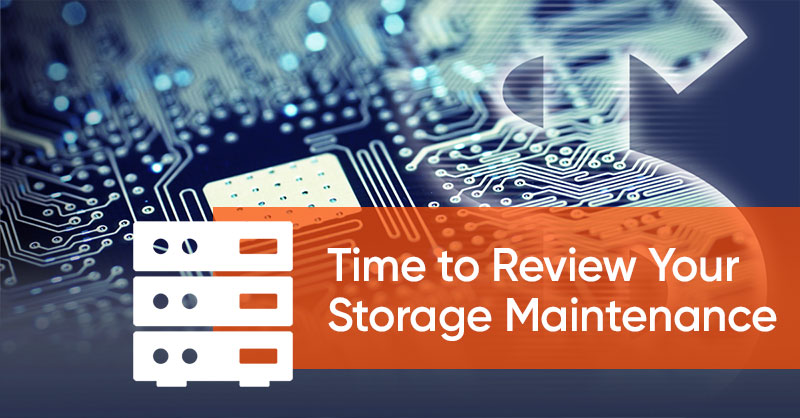Never forget or underestimate the lingering reality that all hardware manufacturers are motivated to sell as much new equipment as possible to as many customers as possible. So, as the warranty period for your storage nears, expect the push for new equipment to feel more like a shove.
According to Gartner, “The useful service life of storage arrays, which is seven to eight years in clean data centers, is almost always greater than their planned service lives.”i Despite that fact, manufacturers will offer incentives to switch out viable storage with next-generation gear, regardless of whether all the latest bells and whistles are needed.
One not-so-subtle factor used to motivate premature upgrades is a drastic jump in price for manufacturer-supplied maintenance in the fourth and subsequent years of a product’s lifecycle. While this may create the perception that switching out equipment makes more sense than extending its useful life, don’t fall for it!
Options exist for IT storage maintenance, you just need to know where to look.
Independent service providers offer substantial savings on Third Party Maintenance (TPM) for all types of hardware, including storage, once past its prime yet still in excellent working condition. According to Gartner, “A core value proposition of TPM providers is lowering the maintenance costs of older storage arrays. Gartner client inquiries and bid reviews confirm that the cost differential between TPM and vendor-supplied support is typically in the 40% to 70% range.” ii
Bring Storage Strategies into Focus
Most of the leading providers of TPM offer internal audits of your environment, providing an excellent opportunity for a fresh view of multi-vendor IT environments. In many cases, specialized tools are used to evaluate the reliability, performance, cost and operational risks of hanging on longer to current- and previous-generation gear.
Typically, these audits include an up-to-date inventory of all assets in your data center along with suggestions and next steps. Noteworthy in any audit are recommendations for storage and other IT assets nearing the end of their original warranty. As this is never a one-size-fits-all situation, auditors can help organizations evaluate and determine specific and individualized future paths for each asset.
Storage Audits
While microcode updates drop quickly by an array’s third or fourth year of use, many IT leaders don’t realize that each array’s useful service life is much longer than the manufacturer’s active marketing life. Consulting with a third-party through the audit process will help bring clear light to whether upgrading is warranted based on new and enhanced functionality or if hanging onto equipment longer frees up much-needed budget for other strategic business or IT initiatives.
When the audit is completed, a detailed picture of current operations—as well as valuable insight into the future—come into sharper focus. The bottom line: It’s almost always judicious to put off storage upgrades unless dictated by business priorities. As Gartner notes, “TPM does impact residual operational risk, but often not to the extent claimed by vendors that are keen to create fear, uncertainty and doubt in the minds of their customers.” iii
Interested in how an audit works?
Read about our process with our proprietary tool, ClearViewSM
Level the Playing Field
Another benefit from an independent maintenance audit is the ability to level the competitive playing field as maintenance wavers make it difficult for non-incumbent storage vendors to gain traction in order to provide their own value. Gartner reports, “Client inquiries and bid reviews show that the value of these waivers is typically 10% to 15% of the system’s actual sales price for hardware, and 15% to 20% for software per year. By comparison, third-party hardware maintenance is commonly priced 40% to 70% below vendor-provided hardware maintenance, or 3% to 9% of the system’s hardware cost to the user. TPM customers save even more as they commonly drop annual software maintenance when they go to TPM because their arrays’ microcode is mature.” iv
By reducing the value of these wavers through TPM, storage competitors have an opportunity to reduce financial barriers of entry into new accounts. Moreover, sole-source situations result in vendor lock-in, which never puts the customer in an advantageous position. TPM forces incumbent sales teams to be more transparent about pricing and more aggressive when it comes to discounting.
Because of this, TPM offers a compelling opportunity to reduce costs, negotiate lower rates from vendors and/or extend the useful service life of installed storage arrays.v In the meantime, IT staff can focus on projects that otherwise would go by the wayside while enjoying improved productivity as well as the reduced hassle and training that comes with skipping an immediate upgrade.
While the prices of manufacturer-provided maintenance soar after the original warranty ends, what should be abundantly clear is there are myriad opportunities to lower operating expenses. With a fresh perspective, you’ll be surprised at the multitude of options for gaining greater control over your storage and budget.
Want to learn more?
Contact us for an audit or a quote to help get you started.
i Gartner, Lower Both Storage Acquisition and Ownership Costs by Using Third-Party Maintenance, Stanley Zaffos, 3 March 2017
ii Gartner, Ibid.
iii Gartner, Ibid.
iv Gartner, Ibid.
v According to Gartner, “A core value proposition of TPM providers is lowering the maintenance costs of older storage arrays. Client inquiries and bid reviews confirm that the cost differential between TPM and vendor-supplied support is typically in the 40% to 70% range. As such, TPM represents a significant opportunity to reduce costs, negotiate lower rates from vendors and/or extend the useful service life of installed storage arrays. TPM does impact residual operational risk, but often not to the extent claimed by vendors that are keen to create fear, uncertainty and doubt in the minds of their customers.” Gartner, Lower Both Storage Acquisition and Ownership Costs by Using Third-Party Maintenance, Stanley Zaffos, 3 March 2017.



